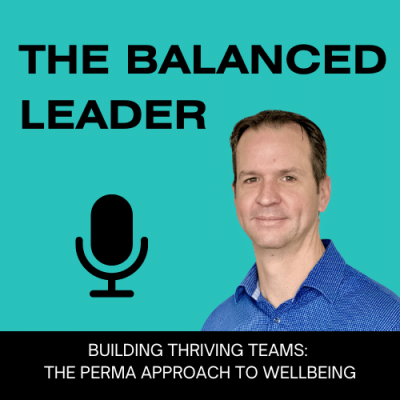In this week’s episode of The Balanced Leader Podcast I introduce the PERMA framework, a holistic approach to fostering workplace satisfaction and fulfillment.
PERMA is one of the most enduring wellbeing frameworks around, originally developed by positive psychology pioneer Martin Seligman. PERMA is an acronym and it stands for Positive Emotion, Engagement, Relationships, Meaning, and Accomplishment.
Throughout this episode I provide actionable strategies for leaders to create a supportive and thriving work environment using this framework. Whether you’re a seasoned leader or new to a leadership role, this episode offers valuable insights to enhance workplace culture and promote employee wellbeing.
Chapters
00:25 Introducing the PERMA Framework for Wellbeing
01:58 Positive Emotion
03:01 Engagement
03:57 Relationships
05:13 Meaning
06:05 Accomplishment
07:18 Implementing PERMA in Your Team

References:
- Seligman’s PERMA+ Model Explained: A Theory of Wellbeing https://positivepsychology.com/perma-model/
FULL TRANSCRIPT
This is the Balanced Leader Podcast, the podcast that helps leaders elevate their wellbeing and create healthier workplaces. My name is Rob Hills and I am your leadership and wellbeing coach. Today, I want to talk to you about how you can increase the wellbeing for your team. To do this, I want to introduce you to a simple framework that can shape the way you approach wellbeing at work, and it’s called the PERMA framework.
By using this framework, you can ensure that you’re hitting on a range of factors to help your team thrive. You may want to take some notes for this episode, but if you’re like me and you’re constantly doing other things while listening to the podcast, all the notes from today’s episode are on my website, www.robhills.com.au.
So the PERMA model is one of the most broadly used well being frameworks. [00:01:00] It was developed by positive psychology pioneer Martin Seligman. PERMA is actually an acronym that stands for Positive Emotion, Engagement, Relationships, Meaning, and Accomplishment. These five dimensions are essential pillars of well being that, when we nurture them, can lead to happier and more fulfilled lives, both personally and professionally.
In fact, research from Kern, Waters, Adler and White in 2014 have shown significant positive associations between each of the core elements of PERMA and things like job satisfaction, life satisfaction, physical health, vitality, and commitment within organisations. So let’s dive deeper into each dimension and I’ll give you some examples along the way of how you can integrate them into your leadership practices to nurture a thriving workplace culture.
The P stands for [00:02:00] positive emotion. The framework states that it’s crucial to cultivate positivity in our workplace environment. As a leader, that should be part of our core role. Anyway, we are the thermostat that sets the temperature for the rest of the team. And don’t forget, mood is contagious. So what mood are your team catching from you?
As a leader, how do we apply this with our team? This can be as simple as starting meetings with expressions of gratitude or celebrating team achievements, no matter how small. It’s about recognising individual contributions publicly or providing opportunities for team members to share their own personal wins.
This can help boost morale and it creates a positive team environment. In my current team, we do this through our regular Monday meetings. There is a standing agenda item that everyone goes through. It’s called shout outs. Now you don’t have to give a shout out to someone else in the team, but invariably most people find a reason to say why they are grateful to one of their [00:03:00] teammates.
The E stands for engagement. We all know that engaging work leads to a sense of flow, where time seems to fly by, because we’re fully immersed in what it is we’re doing. Have you ever experienced that? Where you’re in a state of flow, where time seems to pass by effortlessly, and hours could have passed by in what feels like minutes?
So as a leader, how do we apply this in our team? As leaders, we can facilitate engagement by aligning our employees strengths with their tasks. It’s taking a strength based approach to task allocation, encouraging autonomy and creativity with our team allows them to feel a sense of ownership over their work, which often leads to increased engagement and higher productivity.
It may be as simple as asking your team what work they really enjoy doing. And then trying to give them more of that type of work. I know it seems like a simple concept, but it can have a really great impact. The R stands for relationships. [00:04:00] The framework also outlines that building strong relationships in the workplace is essential for our wellbeing.
I get this can be a little bit harder when you’re working from home, but it doesn’t mean we shouldn’t be trying. So as a leader, in what ways can we affect this in our teams? Firstly, encouraging open communication, collaboration and empathy among team members is essential. This helps to build trust and connection, which is the foundation of relationships.
Also, to foster a sense of belonging, it’s helpful to create opportunities for social interaction, such as team building activities or lunchtime gatherings. There are a number of ways you can do this, but for me, I really like inviting people to go for a walk. It’s great to get outside for some fresh air and just have a chat.
Sometimes we talk about work, but sometimes we just talk about life. And I find it a great way to build relationships with my team, and also get some time outside as well. Investing in building a [00:05:00] supportive and inclusive work environment not only enhances well being, but also improves teamwork and overall performance.
Work is meant to be fun. And when we’re having fun as a team, we feel more connected. The M stands for meaning. The framework explains that employees are more likely to feel fulfilled and motivated when they find meaning in their work. Makes sense, right? So as a leader, how do we apply this in our team? As leaders, we have a responsibility to help employees connect their daily tasks to a larger purpose or mission.
In one of my old teams, I created a mission for our team that was simple, but it ultimately aligned to what we were there to do. We were in a leadership training team. So the mission was we helped develop leaders, even created a sign and I put it up on the wall so everyone could see it when they walked in the room, it helped us tie what we were doing on a daily [00:06:00] basis to what our overall mission was, and also the overall mission of our organisation.
The A stands for accomplishment, and this is the last element of the framework. It explains that recognising and celebrating achievements. is crucial for maintaining motivation and a sense of accomplishment. So what does this look like for your team? As leaders, we should be providing regular feedback, acknowledging progress, and celebrating milestones, both big and small.
As a team, why not come up with a number of different ways that you can celebrate success? It may be ringing a bell when you have a win, or having a celebratory morning tea, or stopping and dancing around the office when something amazing happens. These are all actually examples of ways teams that I’ve been a part of have celebrated success.
So that’s it! That’s the five elements of PERMA. Positive emotion, engagement, relationships, meaning, and [00:07:00] accomplishment. It’s a great model for us as leaders to help reflect on our team and our own situation to ensure we’re covering off all the core elements of wellbeing. Are there other elements of wellbeing?
Of course. But I really like the simplicity of this model and it has stood the test of time. So you’re probably thinking, where do I start? For me, I would sit down with the team, introduce them to the PERMA model and what it means, and then I’d ask them how they would like to cover off each of the five elements.
Let them choose ways to implement this model and each of those elements in ways that work for them. No two teams are going to be the same. By using the PERMA framework, we can help create a workplace culture where we make it a great place to work and our team thrives. I don’t know about you, but I absolutely want that for my team and for me.
We spend a lot of time at work, so we need to invest in making it a great place to be. That’s it for this week’s [00:08:00] episode. I hope you enjoyed it. If you haven’t already, please leave us a review on the platform you’re currently listening to and follow the show.
See you next time.
